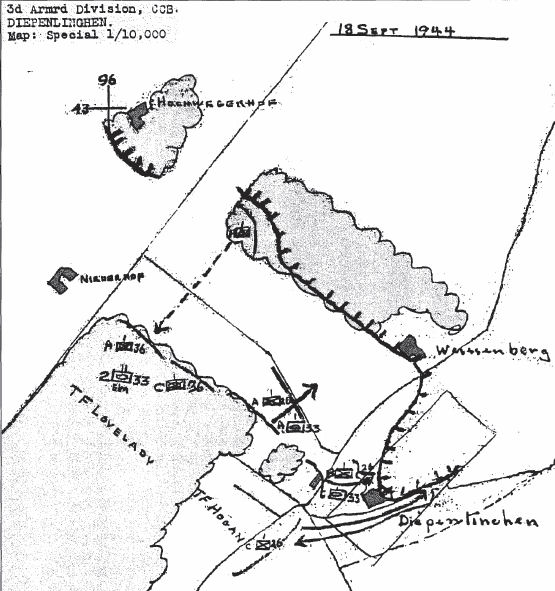1st Battalion, 26th Infantry Regiment (1st Infantry Division)
13 - 22 September 1944
Task Force Hogan at Büsbach had been relieved on the morning of 18 September, moved back through Dorff, and ordered to prepare for an attack on Donnerberg, above Stolberg. At 1130 new orders were received to occupy an assembly area in the woods 1000 meters west of Mausbach and 1800 meters southwest of Diepenlinchen, there to prepare for an attack on Weissenberg. Upon reaching the assembly area, Lt. Col. Hogan and Major Adams learned that Company C had been attacked by a superior force, had sustained many casualties, and had not only failed to take Weissenberg, but had lost Diepenlinchen. However, elements of Company C were believed to be holding out in Diepenlinchen. The two commanders promptly concerted a plan to retake Diepenlinchen: Company B would advance on foot to the northeast through the woods, while supporting tanks would move up the road on the right rear of the infantry. When Company B came abreast of Diepenlinchen, it would turn right to attack to the east, joining the tanks in a coordinated operation to clear the town from west to east. Company A would follow Company B until the latter turned to attack into the town, then continue to the edge of the woods facing Weissenberg, there to prepare for a frontal assault.

Around 1700 Company A (dismounted) attacked across the pasture south of Weissenberg, and after losing three tanks and 14 infantrymen, retired and dug in for the night.
Company B's attack, supported by mortars and artillery, had been more successful, if slow. The infantry had to fight from house to house, and it was dark before the town was cleared. Forty-nine German prisoners were taken, and the troops from Company C who had been captured in Diepenlinchen were liberated. During the day, Company D's 81mm mortar platoon, commanded by Lt. Steven B. Phillips, expended all its ammunition; urgent requests for re-supply had to be submitted up the chain of command, eventuating in the arrival the next day of a truck load of mortar ammunition driven 200 miles direct from Paris.
Shortly after dark on 18 September an enemy counterattack developed from the woods around Weissenberg, apparently seeking to turn Company A's exposed left flank. The 1/ 26th Infantry Ammunition and Pioneer Platoon was thrown in to strengthen that flank, and the attack was beaten off.
The following morning, 19 September, Companies B and C attacked into the factory area north of Diepenlinchen - a confusion of thick walls, rock piles, and other obstacles - but the enemy there defended tenaciously, and progress was slow and costly. One veteran of Company B, Bert H. Morphis, remembered what happened thus:
"We attacked an area around a cement plant...The resistance was very stiff, and we fought all day with little headway. For some reason the Germans had concentrated a lot of artillery and mortar fire in this area. All day long they plastered us, to the point that we finally had to dig in for protection. My platoon was in an area with a large pile of sand; so I simply scooped out a hole big enough to curl up in and lay down on my side with my knees pulled up to my chest. The incoming artillery was so intense all I could do was lie there and hope. I abandoned all hope when I heard what I identified as a 120 millimeter shell coming right at me. From long experience I could tell it was going to fall right on top of me. So I simply gave up and prepared to die. I don't even remember being scared. I simply was resigned to the inevitable. It seemed I heard the shell for an eternity before it exploded. Of course, it was actually only a few seconds. Anyway, the next thing I remembered was someone's hand grasping my helmet and pulling my head out of the sand. Many hands were digging me out of my self-made grave. Had it had not been for good buddies who risked their lives by getting out of their protective holes to dig me out, I would still be in European soil. It was a miracle I was alive. Apparently the shell landed right in the bend of my legs and buried in the sand before it exploded. In ordinary soil it would have exploded immediately, and they would not have found enough of me to bury. As it was, the sand cushioned the effect of the explosion enough to save my life. I was knocked unconscious, one ear drum was ruptured, the backs of both my legs were torn up, and I was filled with shrapnel (shell fragments) from knees to my waist..." [Morphis, B.H. Squad Leader. 26th Infantry Regimental Association. 1998.]

